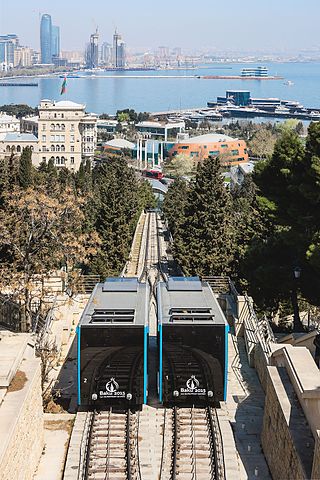
A funicular is a type of cable railway system that connects points along a railway track laid on a steep slope. The system is characterized by two counterbalanced carriages permanently attached to opposite ends of a haulage cable, which is looped over a pulley at the upper end of the track. The result of such a configuration is that the two carriages move synchronously: as one ascends, the other descends at an equal speed. This feature distinguishes funiculars from inclined elevators, which have a single car that is hauled uphill.
Monongahela or Mon Valley may refer to:
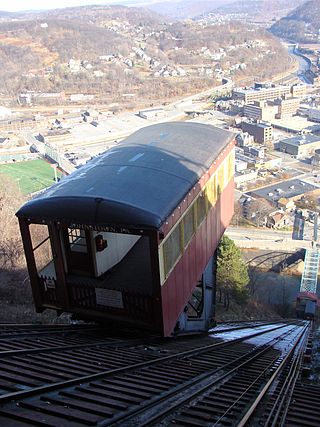
The Johnstown Inclined Plane is a 896.5-foot (273.3 m) funicular in Johnstown, Cambria County, in the U.S. state of Pennsylvania. The incline and its two stations connect the city of Johnstown, situated in a valley at the confluence of the Stonycreek and the Little Conemaugh rivers, to the borough of Westmont on Yoder Hill. The Johnstown Inclined Plane is billed as the "world's steepest vehicular inclined plane". It can carry automobiles and passengers, up or down a slope with a grade of 71.9%. The travel time between stations is 90 seconds.

The Duquesne Incline is a funicular located near Pittsburgh's South Side neighborhood, scaling Mt. Washington in the United States. Designed by Hungarian-American engineer Samuel Diescher, the incline was completed in 1877.

The Monongahela Incline is a funicular located near the Smithfield Street Bridge in Pittsburgh, Pennsylvania. Designed and built by Prussian-born engineer John Endres in 1870, it is the oldest continuously operating funicular in the United States.
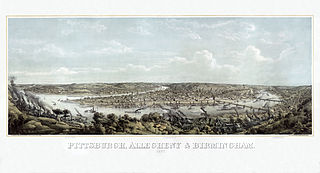
In 1763, King George III provided John Ormsby approximately 2,400 acres (9.7 km2) along the south bank of the Monongahela River as payment for his services during the French and Indian War. The land was then divided into four boroughs: South Pittsburgh, Birmingham, East Birmingham, and Ormsby. The four boroughs were annexed into the City of Pittsburgh in 1872. These areas, collectively, provided for the foundation of the South Side as it is known today.

The Wabash Tunnel is a former railway tunnel and presently an automobile tunnel through Mt. Washington in the city of Pittsburgh, Pennsylvania, United States. Constructed early in the 20th century by railroad magnate George J. Gould for the Wabash Railroad, it was closed to trains and cars between 1946 and 2004.
The Clifton Incline was a funicular that operated from 1889 to 1905 in what is now the Perry Hilltop neighborhood of Pittsburgh, Pennsylvania. It extended from its base at Sarah Street at the intersection with Myrtle Street to its top landing at Clifton Park near the end of Clifton Street.
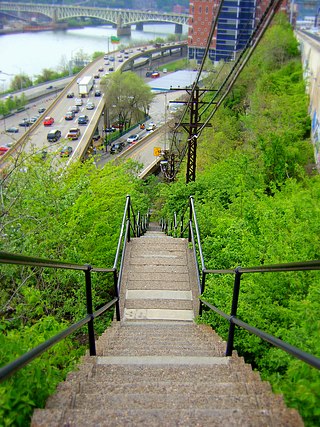
The Fort Pitt Incline was a 10 ft gauge funicular railroad in the Bluff neighborhood of Pittsburgh. Opened in 1882, the incline ran from 2nd Avenue to Bluff Street, a distance of 350 feet (107 m), and a vertical distance of 135 feet (41 m). The designer was Samuel Diescher.
Samuel Diescher was a prominent Hungarian-American civil and mechanical engineer who had his career in the United States. After being educated at universities in Karlsruhe and Zurich in Europe, he immigrated to the United States in 1866 and settled in Cincinnati, Ohio. There he supervised construction of his first inclined plane. He later moved to Pittsburgh, Pennsylvania, where he worked with John Endres on the Monongahela Incline (1870), the first passenger incline in the city.
Caroline Endres Diescher, also known as Caroline Endres, was notable as one of the first female engineers in the United States. With her father John Endres, who was born and educated in Prussia, she designed two inclines in the Pittsburgh area: the Monongahela Incline and the Mount Oliver Incline, which opened in 1870 and 1871, respectively.

Castle Shannon Incline Number 2 was an inclined cable railway in Pittsburgh, Pennsylvania. It was originally designed by Samuel Diescher, and opened in 1892 as part of the Pittsburgh and Castle Shannon Railroad as a means of transporting passenger traffic over Mt. Washington in concert with the Castle Shannon Incline. From the top station at Bailey Street, adjacent to the Castle Shannon Incline top station, No. 2 ran down hill west of Haberman Avenue, ending at Warrington Avenue.
The St. Clair Incline, also known as the South Twenty-second Street Incline, was built in 1886–1888 and operated by St. Clair Incline Plane Company. It was a double track incline on the South Side Slopes of Pittsburgh from Josephine St. to Salisbury St. The lower station was near the intersection of S. 22nd Street and Josephine. The upper station was on Salisbury Street across from the former Fort Laughlin site eventually occupied by Arlington Playground. The incline was 2,060 ft (628 m) long, with a vertical rise of 361 ft (110 m). It was designed by engineer J. H. McRoberts. As it carried both freight and passengers over steep tracks laid on the ground, it could be considered to be a cable railway. Its path was not of constant slope but became progressively steeper toward the top, tracing a parabolic arc. It is uncertain exactly when the incline closed permanently, but it was reported as shut down in a 1932 Associated Press article about the "passing" of Pittsburgh's inclines. The structure was dismantled in 1934.
John J. Endres was a civil engineer known for designing the Monongahela Incline, the first passenger incline in the United States, in Pittsburgh, Pennsylvania. The incline was originally steam powered and ran on wooden tracks. Born in Prussia and educated in Europe, Endres had immigrated to the United States and settled in Cincinnati, Ohio. His daughter, Caroline Endres, born and educated in the US, became one of the first women engineers in the country. She assisted him on the Monongahela Incline.

The Pittsburgh and Castle Shannon Plane was a 3 ft 4 in narrow gauge incline railway that ran from the northern end of the Pittsburgh and Castle Shannon Tunnel to Carson Street in Pittsburgh, Pennsylvania.
The Norwood Incline was a funicular railway located just outside Pittsburgh, Pennsylvania, United States. It operated from 1901 to 1923 between its lower station on Island Avenue, McKees Rocks, and its upper station in Norwood Place, Stowe Township. Originally free to ride, it got the nickname "Penny Incline" after it started charging a one-cent fare. Its two narrow-gauge tracks were formed by only three rails, the middle rail being shared by both tracks, except at mid-slope where the tracks separated to allow the upbound and downbound cars to pass each other.

The Troy Hill Incline, also known as the Mount Troy Incline, was a funicular railway located in old Allegheny, Pennsylvania, which is now the North Side of the city of Pittsburgh.

The Penn Incline, also known as the 17th Street Incline, was a funicular railroad that ran between the Strip and Hill districts in Pittsburgh, Pennsylvania. It operated from 1884 to 1953.
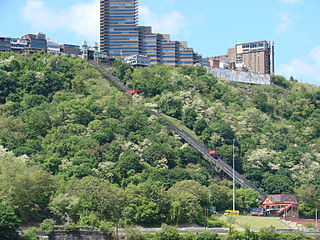
Mount Washington is a hill in Pittsburgh, on the southern banks of the Monongahela River and Ohio River.













